Did you know that Cabo and Southern California anglers set new records last October, with dozens of yellowfin tuna catches exceeding 200 pounds? This isn’t just a streak of good luck—it’s the result of unique ocean conditions and refined sportfishing techniques. If you dream of reeling in one of these ocean giants, October is your month. Dive in to uncover expert yellowfin tuna fishing tips, location secrets, and winning strategies from veteran fishing guides. Whether you’re a first-timer or a seasoned angler, this special guide will help you maximize success in the heart of tuna season.
Unveiling the October Yellowfin Tuna Fishing Boom in Cabo
The yellowfin tuna fishing boom explodes every October along the Pacific coast, especially in Cabo San Lucas. Warm waters, abundant bait fish, and ideal ocean currents fuel this unparalleled season—an annual spectacle that draws anglers from around the globe. For those looking to break personal bests, this is the moment when tuna season is at its fiercest and most fruitful. With expert charter fishing guides and cutting-edge equipment, anglers routinely report double-digit catches and frequent battles with monsters weighing over 150 pounds.
As the deep sea fishing community swells, so does the competition and excitement. October’s weather windows and consistently teeming schools of yellowfin tuna create a “perfect storm” for fishing in south Baja and beyond. The region’s top fishing guides, equipped with up-to-the-minute intel and tried-and-true techniques, ensure every fishing trip offers a shot at a trophy fish. In fact, last season’s statistics from both Cabo and Southern California highlight this period as the highest-yielding month for yellowfin tuna fish—cementing October as the absolute prime time for record-breaking catches and unforgettable adventure.
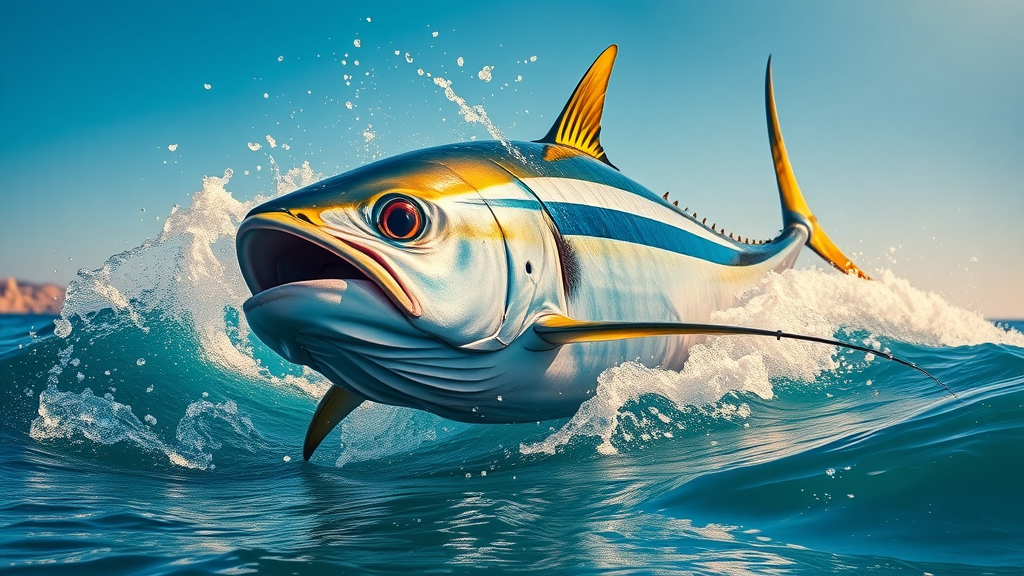
Startling Statistics: The Rise of Record-Breaking Yellowfin Tuna Catches
Sportfishing reports and tournament logs reveal a striking trend: the average yellowfin tuna caught in October has surged, with multiple landings above the 250-pound mark. Last year, Cabo San Lucas saw its largest recorded yellowfin tuna fish in over a decade, while the San Diego fleet posted an uptick in triple-digit catches. On some charters, lucky crews reeled in five or more fish in a single day—each pushing the limits of both angler and gear. This pattern isn’t anecdotal; it’s endorsed by catch logs, fishing guide word-of-mouth, and regional sportfishing data.
This surge is attributed to a “goldilocks” convergence: warmer sea temperatures, a flourishing population of bait fish, and the maturation of migrating schools. These conditions, accentuated by the shifting of the Pacific currents, transform October into a truly special month for anyone passionate about tuna fishing. Not only are the fish bigger—but they’re also more aggressive and more abundant, doubling your chances of success if you know where, when, and how to fish.
Why October Is Prime Time for Tuna Fishing in Southern California and Cabo
October is not just another chapter in the tuna season—it’s the climax. The Pacific waters reach their peak temperature, and hundreds of thousands of yellowfin tuna make their annual migration northward through the open water highways. Southern California, San Diego, and Cabo emerge as legendary battlegrounds, teeming with schools of tuna ready for action. Local fishing experts agree: these conditions rarely align so perfectly outside this narrow window.
What's more, autumn’s moderated storms and gentle breezes create ideal sea states—making it easier to spot bait fish activity and chasing seabirds, two classic signs that yellowfin are near. Both seasoned and new anglers benefit, as the calm yet lively open water settings mean less time searching and more time fighting fish. Simply put, the odds tilt dramatically in your favor if you plan your tuna fishing trip for October in these Pacific hotspots. It’s the moment where preparation meets opportunity for every sportsman and woman.
What You'll Learn About Yellowfin Tuna Fishing and Deep Sea Success
- How to maximize your yellowfin tuna fishing trips this October
- Leading techniques for landing giant yellowfin tuna fish
- Essential gear and bait for deep sea and sea fishing
- Pro guidance for tackling tough fights and reading ocean conditions
- Insider tips from Southern California and San Diego fishing guides
Understanding Yellowfin Tuna: Biology, Habits, and Tuna Season
Yellowfin Tuna vs. Bluefin and Yellowfin Tuna: Key Differences
While often mentioned in the same breath, yellowfin tuna and bluefin tuna are distinct both in appearance and behavior. Yellowfin, or Thunnus albacares, are easily recognized by their vibrant yellow dorsal and finlets, plus a more streamlined body built for high-speed chases. In contrast, bluefin tuna are bulkier, with deeper bodies and a more muted blue-black coloring. Both are powerful, but bluefin tend to reach even greater weights—though a giant yellowfin remains a formidable opponent on any line.
Beyond looks, their seasonal presence sets them apart. Yellowfin are more common in warmer waters and dominate the sportfishing headlines each October from Cabo to Southern California. Bluefin have a shorter season overlap but are better known for their winter runs and headline-grabbing auction prices. For most anglers, yellowfin represent the ultimate blend of availability, fight, and reward, especially during the critical fall migration period.
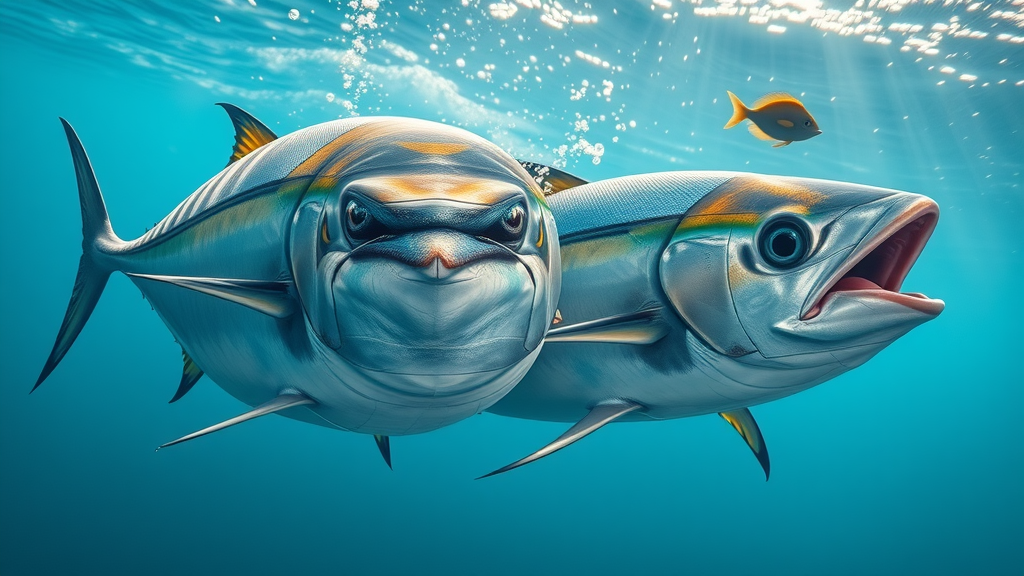
Migration Patterns and Their Impact on Tuna Fishing
Understanding the migration patterns of yellowfin tuna is key to predicting your tuna fishing success. Every summer and early fall, changing water temperatures and food availability spark massive movements of these tuna. Yellowfin travel in large, fast-moving schools, chasing bait such as anchovies and sardines along the Pacific coast. For those targeting fishing in south areas or beyond, tracking these migrations can dramatically increase your catch rates.
Experienced anglers rely on clues: water temp readings, active bait fish schools, and the gathering of seabirds that signal tuna below. The annual October push sees schools moving in from open water, concentrating close to Cabo and the Southern California coastline. This alignment not only boosts the density of fish available to recreational charters but also shortens travel time to prime sea fishing grounds—a win for both entry-level and experienced anglers seeking that epic catch.
How Tuna Season Shapes Yellowfin Tuna Fish Availability
Tuna season in the Pacific dictates when and where you’ll find yellowfin tuna fish. Generally, the season runs from late spring through early fall, trending toward its peak in October. Several factors determine its exact start and end, including sea temperatures, prey concentrations, and Pacific current patterns. Yellowfin are more active and feed aggressively in the warmer portions of the year, making them both easier to find and far more likely to strike your live bait or lures.
By planning your deep sea fishing or tuna fishing trip for October, you leverage the intersection of optimal conditions—plentiful fish, ideal weather, and prime oceanographic features—to maximize your chances of success. Missing this window often means chasing scattered, less predictable schools or waiting months for action to return to its fever pitch.
Essential Gear for Yellowfin Tuna Fishing Success
- Best rods and reels for deep sea yellowfin tuna fishing
- Recommended tackle and line strengths for tuna fishing
- Choosing bait and lures for yellowfin tuna fish
- Safety and comfort essentials for fishing in south and at sea
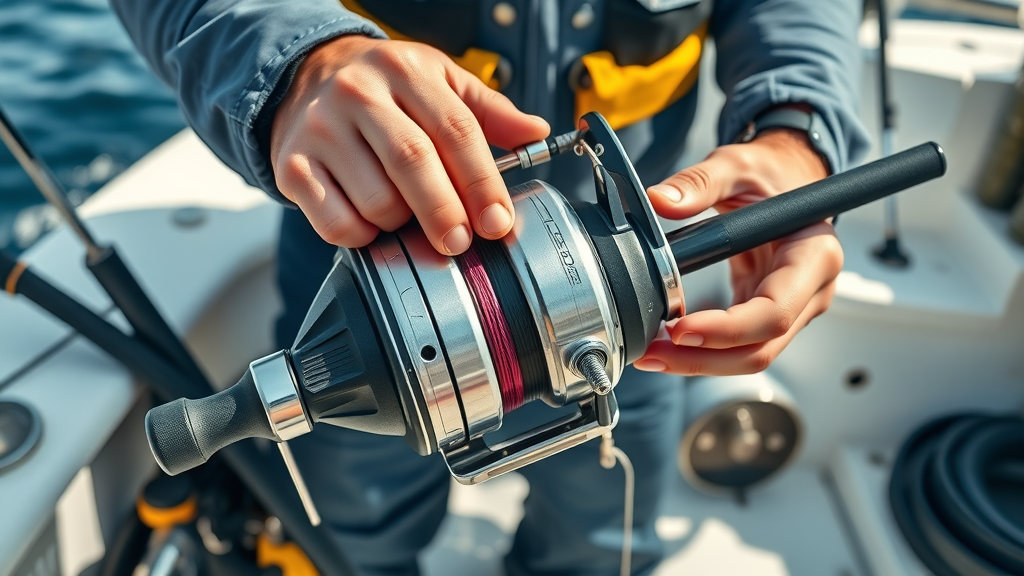
Landing giant yellowfin tuna is about the right match of brawn and finesse—and your gear will make or break your battle. The best set-ups start with heavy-duty rods (classed 50-130 lbs) paired with high-capacity, saltwater-grade reels, capable of holding hundreds of yards of 80-130 lb braided main line or mono topshot. Matching tackle to tuna size is essential: light tackle may boost sport but risks heartbreak against a true giant. Equip yourself with robust hooks, leader material (often 100-200 lb fluorocarbon), and abrasion-resistant lines to withstand teeth and thrashing.
Bait selection plays a huge role. Live bait (especially sardines and mackerel) consistently outperform artificials for picky fish, but trolling with skirted lures or poppers can trigger aggressive strikes from fast-moving schools. Don’t overlook comfort: modern foul-weather gear, polarized sunglasses, and non-slip boots will keep you sharp and safe on the bluewater. Finally, a well-organized tackle box prevents wasted time—a luxury you can't afford when a potential record-breaker is on the line.
Tactics: Techniques to Increase Your Yellowfin Tuna Fishing Success
Live-Baiting vs. Trolling: Which Works Best for Giant Yellowfin Tuna?
Live-baiting and trolling stand as the two mainstays of yellowfin tuna fishing, yet each brings distinct advantages depending on conditions and targeted fish size. Live bait—free-swimming sardines, anchovies, or mackerel—offers an irresistible, natural presentation that entices even the most cautious giants. This technique shines when schools are finicky or pressured. Drift along likely zones, pitch a lively bait, and be ready for explosive hits at depth.
On the other hand, trolling lures or rigged dead baits enables you to cover more water, especially when tuna schools are scattered. High-speed trolling with skirted lures, cedar plugs, or even modern poppers can quickly locate active tuna fish. Many pro crews alternate between styles during a single trip, switching to live bait after locating fish via trolling passes. If your aim is a 200+ pound yellowfin, be prepared to adapt—and have rigs ready for both in your arsenal.
Reading Water: Finding the Best Yellowfin Tuna Fishing Spots in Cabo and Southern California
Not all blue patches are equal. Pros know that productive yellowfin tuna fishing depends on reading “fishy” water—spots where bait fish, current edges, and surface activity collide. In Cabo and Southern California, seasoned guides target underwater high spots (banks or seamounts), color breaks where warm and cool water meet, and any area swarmed with diving birds or boiling bait. These are classic signs that schools of tuna are on the feed.
Your secret weapon? Local knowledge. Experienced crews, especially those based in Cabo San Lucas or San Diego, use electronics like sonar and radar to pinpoint schools of tuna. But don’t ignore traditional observation: lines of bait, crowning seabirds, and even floating debris can point the way to epic hauls. Trust your fishing guide, stay alert, and be ready to move quickly as the bite can shift mile by mile during an active day.
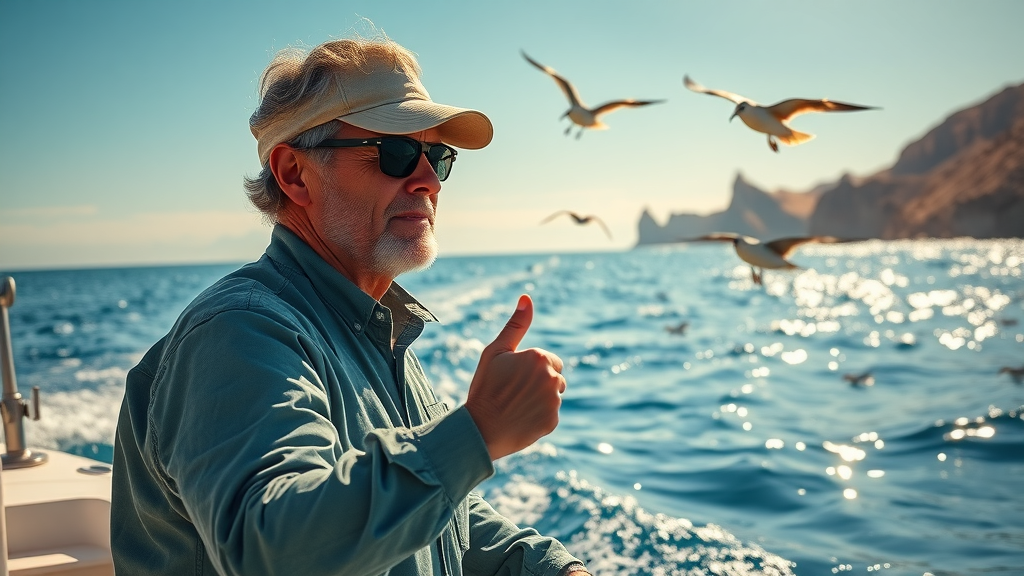
Timing Your Tuna Fishing Trip for Maximum Results
Timing is everything when it comes to yellowfin tuna fishing. In both Cabo and Southern California, early mornings and late afternoons tend to spark the hottest action. Water clarity, tidal swing, and lunar phase all play crucial roles—savvy captains consult tide charts and moon tables before every departure. Certain “bite windows” correspond with water temperature spikes or tidal changes, drawing bait fish up and triggering aggressive feeding frenzies among tuna.
Late moon phases and tide shifts are critical—book your fishing trip accordingly or talk to local pros for up-to-date scheduling. Many of the season's largest fish have fallen during short twilight strikes or just as a new weather front approaches. “Mastering bait selection and timing is what separates the pros from the rest,” says local Cabo fishing guide, Raul Torres. Prioritizing timing, alongside refined tactics, will put you in the right place—at exactly the right moment—for that unforgettable strike.
Deep Sea Fishing Tips: Overcoming Challenges of Tuna Fishing
Fighting Giants: How to Land a 200+ lb Yellowfin Tuna
The thrill of battling a 200+ lb yellowfin tuna is unmatched. Yet, turning the odds in your favor requires preparation, patience, and the right battle plan. First, ensure your gear is up to spec—this isn’t the time to test light tackle. Use a heavy-class rod and high-drag reel to exert constant pressure, and be prepared for long, punishing runs. Pay close attention to your drag setting; too tight and you risk pulling hooks, too loose and the fish may empty your spool.
When the fight starts, maintain a steady, even tension on the line. Let the fish tire itself out with runs, then reclaim line during its pauses. Footwork is crucial: brace yourself on deck, keep your body posture strong, and use your legs—never your back—to absorb the shocks. Communicate closely with your crew, especially on longer battles and when the fish “pins” itself deep below the boat. With skill and determination, you’ll experience the ultimate reward: seeing a true giant at the leader, ready for the gaff or a photo before release.
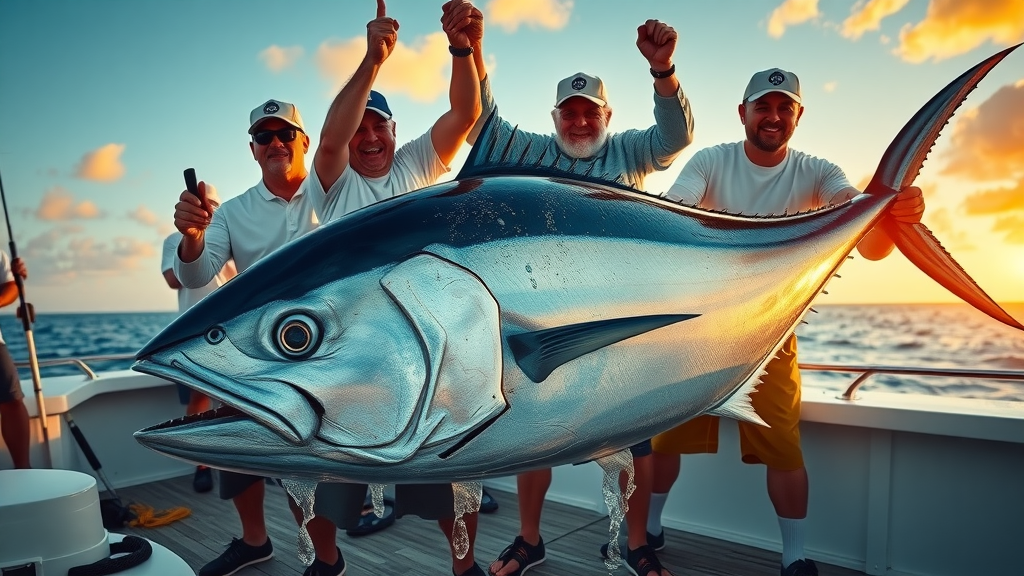
Weather, Tides, and Currents: Optimizing Your Deep Sea Fishing Strategy
The Pacific can shift from calm to chaotic in moments—knowing how to adapt is core to deep sea tuna fishing success. Monitor weather forecasts closely; shifts in barometric pressure or incoming fronts often trigger feeding activity in yellowfin tuna fish. Favorable tides (especially incoming or “building” swings) concentrate bait fish, while strong currents near banks or pinnacles promote nutrient-rich upwelling, drawing in mass schools of tuna.
Preparation and flexibility are vital. If sea conditions change mid-trip—higher winds, shifting currents, or swells—adjust your strategy. Move with the fish, not against the ocean. Top captains often reposition throughout the day, chasing optimal conditions. The key is to remain adaptable, patient, and steady when the going gets tough: “Patience and perseverance are key when fishing for yellowfin tuna in unpredictable ocean conditions.”
Best Places for Yellowfin Tuna Fishing This October
Legendary Grounds: Cabo, Southern California, and San Diego
The holy trinity for October yellowfin tuna fishing: Cabo San Lucas, Southern California, and San Diego. Cabo boasts a vibrant, world-class charter fleet and easy access to deep, rich bluewater. Southern California stretches from San Diego to Santa Barbara, peppered with canyons and offshore banks ideal for large schools of tuna. San Diego, especially, serves as the launchpad for multi-day long-range trips, frequently producing record-sized catches and an unbeatable fishing community spirit.
Anglers flock here for reliability, variety, and sheer numbers of willing yellowfin. Accommodating both novice and expert, these areas offer every amenity from fast sportfishers to affordable, family-friendly charters. Local guides provide up-to-date information on current movements, bait supply, and hot spots, ensuring every trip stands the best chance for an epic catch.
Choosing the Right Fishing Trip and Guide for Success
Selecting the perfect fishing guide or charter makes all the difference. Look for captains with updated catch records and modern, well-maintained boats designed for deep sea or sea fishing. Ask about their approach—do they follow the migration, monitor water temp, or focus on tried-and-true banks? Don’t hesitate to inquire about gear, bait, and included amenities, from tackle fishing setups to safe handling and release of fish.
Experienced local guides maximize every advantage, keeping pulse on changing ocean conditions and tailoring trips for either all-out trophy hunting or high-volume action. Booking early and researching reviews is critical, especially during October’s peak demand. For consistently exceptional trips, trust established booking platforms for curated, customer-vetted packages and guides.
| Destination | Season Length | Average Catch Size | Local Regulations |
|---|---|---|---|
| Cabo San Lucas | July – November | 100–250+ lbs | Two fish per angler per day; licenses required |
| San Diego | June – November | 80–200 lbs | Size/quantity limits enforced; fishing license required |
| Southern California | May – October | 50–150 lbs | Follow state/federal guidelines; permit needed |
Preparation: Planning Your Yellowfin Tuna Fishing Trip
- How to book a tuna fishing trip in Cabo and Southern California
- Building a winning fishing team
- Must-have supplies and licenses
- Packing checklist for yellowfin tuna fishing adventures
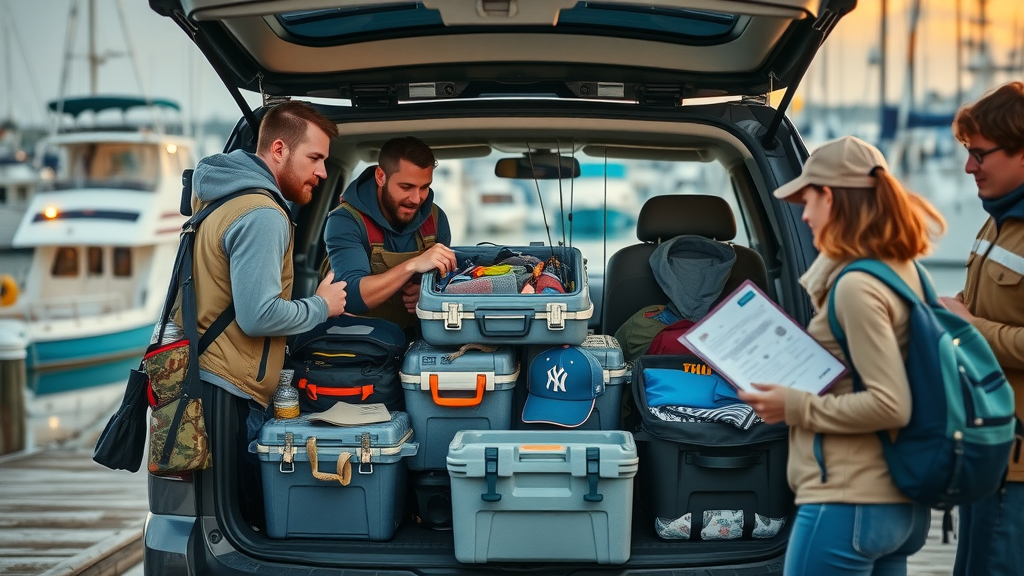
Early planning is the secret to an exceptional yellowfin tuna fishing adventure. Begin by securing your fishing trip with a reputable charter or guide—October dates book fast, especially with top-rated captains. Assemble a strong team: experienced anglers elevate everyone’s chances of success, with each member contributing to spotting, rigging, and landing fish. Don’t forget required supplies: valid fishing licenses for Mexico or California, sun protection, motion-sickness meds, foul-weather gear, coolers for your catch, and the best-tested rods and reels for targeting big tuna.
Create a packing checklist to ensure nothing is forgotten at the dock. Most essential? Confirm your captain provides all tackle, bait, and safety gear, or bring backup items for peace of mind. Review regulations regarding minimum size, catch quotas, and protected areas, which can vary between waters. Organized, thorough preparation translates into stress-free days at sea—and puts you in the best position when opportunity strikes.
FAQs on Yellowfin Tuna Fishing
Where is the best yellowfin tuna fishing?
The most reliable yellowfin tuna fishing grounds are found in Cabo San Lucas, Southern California, and San Diego. These regions consistently produce large tuna, vibrant sea fishing opportunities, and experienced captains who know how to get on “the bite” fast—especially in peak October season.
How old is a 100 lb yellowfin tuna?
A 100-pound yellowfin tuna is typically between five to seven years old. Growth rates depend on factors like habitat, available prey, and competition; Pacific fish often reach this size a bit quicker due to abundant bait and optimal ocean conditions.
How much is a 800 lb bluefin tuna worth?
An 800 lb bluefin tuna can fetch an impressive sum at auction—anywhere from $10,000 up to $70,000 or more. Value depends on the fish’s quality, fat content, market demand, and whether it’s sold in international sushi or sashimi markets.
How hard is it to catch yellowfin tuna?
Catching yellowfin tuna varies in difficulty based on gear, expertise, and targeted size. Most recreational anglers can catch school-sized tuna with standard equipment and guidance, but landing a trophy fish over 200 lbs requires experience, preparation, and sometimes a bit of luck given their power and stamina.
Answers to Common Yellowfin Tuna Fishing FAQs
Knowledge is key for fishing for yellowfin. Always consult the latest regulations, travel with experienced teams, and adapt your approach to changing ocean conditions. With these foundations, anyone can experience the thrill of landing a giant yellowfin tuna in today’s top sportfishing destinations.
People Also Ask: Expanded Answers
Where is the best yellowfin tuna fishing?
Answer: Cabo San Lucas, Southern California, and San Diego are internationally renowned for excellent yellowfin tuna fishing, especially in October.
How old is a 100 lb yellowfin tuna?
Answer: A yellowfin tuna reaching 100 lbs is typically around 5-7 years old, depending on habitat and food availability.
How much is a 800 lb bluefin tuna worth?
Answer: An 800 lb bluefin tuna can fetch between $10,000 and $70,000, depending on quality, season, and market demand.
How hard is it to catch yellowfin tuna?
Answer: With the right methods, preparation, and a bit of luck, anglers can successfully target yellowfin tuna; however, large specimens are notoriously challenging and require experience.
Key Takeaways for Yellowfin Tuna Fishing Excellence
- October brings record opportunities for yellowfin tuna fishing in Cabo and Southern California.
- The right gear, tactics, and timing are essential to land giants.
- Booking through local, reliable vendors is key to a successful fishing trip.
- Stay adaptive: ocean conditions can change quickly and impact tuna fishing success.
Watch expert anglers fight and land giant yellowfin tuna in Cabo and Southern California. See strategy, tackle use, teamwork, and wild ocean scenes for a complete sportfishing experience.
Video Tutorial: Prepping for a Giant Yellowfin Tuna Fishing Trip
Step-by-step video guide on planning, packing, and rigging your gear for a successful yellowfin tuna adventure. From booking the right trip to final tackle selection, see it all in motion.
Ready for Your Yellowfin Tuna Fishing Adventure?
Always Cabo's best vacation vendors with the most reliable packages. At https://curatedcabomx.com.
Summary and Conclusion on Yellowfin Tuna Fishing Success This October
Act now: October’s yellowfin tuna fishing boom in Cabo and Southern California won’t wait. Prep your gear, book with the best, and experience the thrill of landing a giant tuna fish this season!
Sources
- BDOutdoors Fishing Reports
- IGFA Yellowfin Tuna Species Information
- NOAA Fisheries: Yellowfin Tuna
- Curated Cabo MX Sportfishing
For further planning and booking your yellowfin tuna fishing adventure, consider visiting Curated Cabo MX Sportfishing. This platform connects you with top-rated fishing charters, local guides, and essential trip planning resources for Cabo and the surrounding region, ensuring a successful outing. If you’re serious about yellowfin tuna fishing this season, these resources will give you the confidence and local advantage to maximize your chances of landing giants.
 Add Row
Add Row  Add Element
Add Element 




Write A Comment